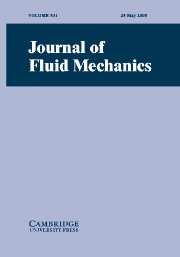Contents
Papers
Homogeneous isotropic turbulence in dilute polymers
-
- Published online by Cambridge University Press:
- 18 May 2005, pp. 1-10
-
- Article
- Export citation
Vortex-induced vibrations of a sphere
-
- Published online by Cambridge University Press:
- 18 May 2005, pp. 11-47
-
- Article
- Export citation
Morphology of a stream flowing down an inclined plane. Part 1. Braiding
-
- Published online by Cambridge University Press:
- 18 May 2005, pp. 49-58
-
- Article
- Export citation
Viscoelastic effects on interfacial dynamics in air–liquid displacement under gravity stabilization
-
- Published online by Cambridge University Press:
- 18 May 2005, pp. 59-83
-
- Article
- Export citation
Mode interaction and the bypass route to transition
-
- Published online by Cambridge University Press:
- 18 May 2005, pp. 85-111
-
- Article
- Export citation
Very fine structures in scalar mixing
-
- Published online by Cambridge University Press:
- 18 May 2005, pp. 113-122
-
- Article
- Export citation
Generalized semi-geostrophic theory on a sphere
-
- Published online by Cambridge University Press:
- 18 May 2005, pp. 123-157
-
- Article
- Export citation
The energetics of large-scale internal wave degeneration in lakes
-
- Published online by Cambridge University Press:
- 18 May 2005, pp. 159-180
-
- Article
- Export citation
On the speed of solitary waves running down a vertical wall
-
- Published online by Cambridge University Press:
- 18 May 2005, pp. 181-190
-
- Article
- Export citation
Experimental observations of upstream overdeepening
-
- Published online by Cambridge University Press:
- 18 May 2005, pp. 191-219
-
- Article
- Export citation
A coupled-mode model for the hydroelastic analysis of large floating bodies over variable bathymetry regions
-
- Published online by Cambridge University Press:
- 18 May 2005, pp. 221-249
-
- Article
- Export citation
Polymer statistics in a random flow with mean shear
-
- Published online by Cambridge University Press:
- 18 May 2005, pp. 251-260
-
- Article
- Export citation
Equatorial inertial-parametric instability of zonally symmetric oscillating shear flows
-
- Published online by Cambridge University Press:
- 18 May 2005, pp. 261-291
-
- Article
- Export citation
Vortex shedding from a hydrofoil at high Reynolds number
-
- Published online by Cambridge University Press:
- 18 May 2005, pp. 293-324
-
- Article
- Export citation
Stability of flow through a slowly diverging pipe
-
- Published online by Cambridge University Press:
- 18 May 2005, pp. 325-334
-
- Article
- Export citation
Vortices near barriers with multiple gaps
-
- Published online by Cambridge University Press:
- 18 May 2005, pp. 335-358
-
- Article
- Export citation
The effect of solid boundaries on pore shrinkage in Stokes flow
-
- Published online by Cambridge University Press:
- 18 May 2005, pp. 359-379
-
- Article
- Export citation
